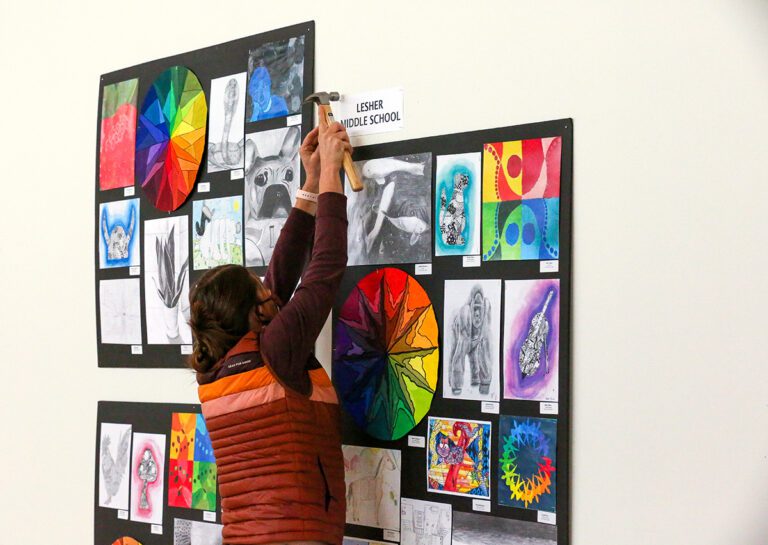The most crucial love affair you will ever have is with yourself! The wear and tear of your profession often roll off your super shoulders. Even so, there are bound to be days when you just need to find ways to care well for your body, brain, and soul.
Self-care is essential for every art teacher because it prevents burnout and promotes conducive learning environments. Nobody will love you better than you love yourself. Luckily, these artist friends have your back! The self-care tips hidden in their art offer you simple ways to invest in yourself as you go about your day as an art teacher.
The self-care tips hidden in these artworks will help you love your art teacher body, brain, and soul better. Find the one you need most today!
Note: Be sure to review all resources and preview all artists before determining if they are appropriate to share with your students.
These tips will help you treat your art teacher body well.
1. Go to bed 30 minutes earlier than you usually do.
When caring for yourself and your body, prioritizing sleep is necessary. Rest keeps your immune system in good health to fight off those pesky colds running rampant in your school. It also helps you manage the challenges you naturally face every day. Sleeping an extra half hour like Henri Rousseau’s sleeping gypsy ensures your body gets the rest it needs!

2. Pack a meal full of stress-busting foods for lunch.
What you eat daily dramatically affects your mood and energy levels. Foods such as whole-grain carbohydrates, bananas, oranges, and leafy greens help manage stress and keep you fueled. Avoid food with high sugar and caffeine content so you don’t crash like Fernando Botero’s picnicker. Instead, try a high-protein snack to boost your energy in the afternoon. Of course, you will also want to ensure that you drink enough water!

3. Start your prep time with a short stretching routine.
When you stretch, you reduce the muscle tension in your body and release serotonin. Serotonin helps stabilize your mood and reduce stress. Yoga stretches are a more practical place to start if you aren’t as flexible as the dancers Edgar Degas loved to paint. Attempt a few of these quick and straightforward stretches before rushing into your prep time to-do list.

These tips will help you keep your art teacher brain sane.
4. Recite a personal mantra on your way to let students in.
Reciting a positive word or phrase overrides mental speech and redirects negative or intrusive thoughts. Chanting your mantra on the way to the door puts you in a more positive mood and empowers you to face the class period ahead. Keith Haring would suggest, “Hear no evil, see no evil, speak no evil.” Come up with the perfect alternative for yourself by following this guide. You can also adopt the practice with your students!

5. Do a short breathing exercise before giving the day’s instructions.
Deep breathing with gusts of wind like Georgia O’Keeffe’s activates the calming, restful regions of the brain. Pause for a minute and shut out the hustle and bustle of your busy students. Next, try box breathing; in through your nose for a count of four and hold for four. Then, breathe out through your mouth for a count of four, and hold again for four. You are now present in the moment and ready to begin teaching!

6. Take five minutes to doodle in between activities or tasks.
Doodling gives your brain a much-needed break from the constant state of alert you maintain as a teacher. During this five-minute respite, you give your brain time to rest and relax. Drawing is particularly rejuvenating for art teachers because it connects them to their creativity. If you need some doodling ideas, design a pattern like Takashi Murakami’s flowers or select one of these prompts.

These tips will help you bring your art teacher soul back to life.
7. Consume content you enjoy while you prep.
Fill the time you spend doing mindless tasks with audio stimulation that makes you happy. Listen to the newest Art Ed Radio podcast or play your classroom music list. Instantly transform tedious tasks like cutting paper, refilling glue bottles, or loading the kiln with quality listening material, like what is being provided by Faith Ringgold’s singer!

8. Pop in to chat with your work bestie between classes.
High-quality relationships and feeling connected to people are public health musts. For this reason, time with your best work pal is a top priority. Your work best friend offers emotional support, practical help, and a much-needed dose of comedic relief. Drop by their room on the way back from your bathroom break and sneak a quick life-giving conversation to keep you going, like in Romare Bearden’s piece below.

9. List three things you are grateful for before turning off the lights.
Cataloging what you are thankful for each day helps with well-being, physical health, and mindset. You sow optimism through regular gratitude. Give thanks for big things like the African-Americans depicted by Jacob Lawrence or small things like some of the ones on this list. Then, no matter how tired you are or what happened throughout the day, you can leave on a good note, ready to come back tomorrow!

Adopting strong self-care practices is one of the best ways to love yourself. Pick some easy stretches to release the accumulated tension in your body. Lose yourself in a doodle to give your brain a break. Practice gratitude to maintain a positive mindset about your job. These small shifts and additions to your workday will leave you feeling oh-so loved!
As a parting gift of love to yourself, check out even more ways to care for your body, brain, and soul:
- Taking Care of Your Physical Health (Ep. 333)
- Why Is It Important to Prioritize Yourself During the School Day?
- Keep Calm and Teach Art: 12 Ways to Keep Your Sanity
- Exploring Ideas for Wellness (Ep. 342)
Which self-care tip will you try today?
How else do you love yourself throughout your work day?
Magazine articles and podcasts are opinions of professional education contributors and do not necessarily represent the position of the Art of Education University (AOEU) or its academic offerings. Contributors use terms in the way they are most often talked about in the scope of their educational experiences.





